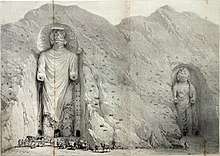
Drawing of the Buddhas of Bamyan, visited by Alexander Burnes in 1832
The Buddhas of Bamiyan were 4th- and 5th-century monumental statues of standing buddha carved into the side of a cliff in the Bamyan valley in the Hazarajat region of central Afghanistan, 140 miles northwest of Kabul at an elevation of 8200 feet. Built in 507 CE (smaller) and 554 CE (larger), the statues represented the classic blended style of Gandhara art.
Quotes
- But who cut the Bamian, still more colossal, statues, the tallest and the most gigantic in the whole world, for Bartholdi’s “Statue of Liberty” (now at New York) is a dwarf when compared with the largest of the five images. Burnes, and several learned Jesuits who have visited the place, speak of a mountain “all honeycombed with gigantic cells,” with two immense giants cut in the same rock.... Central Asian traditions say the same of the Bamian statues. What are they, and what is the place where they have stood for countless ages, defying the cataclysms around them, and even the hand of man, as in the instance of the hordes of Timoor and the Vandal-warriors of Nadir-Shah? Bamian is a small, miserable, half-ruined town in Central Asia, half-way between Cabul and Balkh, at the foot of Kobhibaba, a huge mountain of the Paropamisian (or Hindu-Kush) chain, some 8,500 feet above the level of the sea. In days of old, Bamian was a portion of the ancient city of Djooljool, ruined and destroyed to the last stone by Tchengis-Khan in the XIIIth century. The whole valley is hemmed in by colossal rocks, which are full of partially natural and partially artificial caves and grottoes, once the dwellings of Buddhist monks who had established in them their viharas. Such viharas are to be met with in profusion, to this day, in the rock-cut temples of India and the valleys of Jellalabad. It is at the entrance of some of these that five enormous statues, of what is regarded as Buddha, have been discovered or rather rediscovered in our century, as the famous Chinese traveller, Hiouen-Thsang, speaks of, and saw them, when he visited Bamian in the VIIth century. When it is maintained that no larger statues exist on the whole globe, the fact is easily proven on the evidence of all the travellers who have examined them and taken their measurements. Thus, the largest is 173 feet high, or seventy feet higher than the “Statue of Liberty” now at New York, as the latter is only 105 feet or 34 metres high. The famous Colossus of Rhodes itself, between whose limbs passed easily the largest vessels of those days, measured only 120 to 130 feet in height. The second statue, cut out in the rock like the first one, is only 120 feet (15 feet taller than the said “Liberty”).† The third statue is only 60 feet high — the two others still smaller, the last one being only a little larger than the average tall man of our present race. The first and largest of the Colossi represents a man draped in a kind of toga; M. de Nadeylac thinks (See infra) that the general appearance of the figure, the lines of the head, the drapery, and especially the large hanging ears, point out undeniably that Buddha was meant to be represented.
- Helena Petrovna Blavatsky, The Secret Doctrine vol. II, 1888. (Wheaton, IL: Theosophical Publishing House, 1993)
- You know, when I despair, I don't always have before my eyes the apocalyptic scenes of September 11. ... Often with the two Towers that no longer exist overlap the two Buddhas which the Taliban destroyed in Afghanistan. The two images mix, unite, become the same thing, and I think: have people already forgotten it? Not me. In fact when I look at the two little Buddhas I keep in my living-room which an old monk persecuted by the Khmer Rouge gave me in Pnomh Penh, my heart is tightening. And instead of two small brass Buddhas I see the two huge Buddhas in the valley of Bamiyan.
- Oriana Fallaci. The Rage and The Pride (2002)
- While the Ottomans moved into South-East Europe, the Moghul invasion of India destroyed much of Hindu and Buddhist civilization there. The recent destruction by Moslems in Afghanistan of colossal Buddhist statues is a reminder of what happened to temples and shrines, on an enormous scale, when Islam took over.
- V.S. Naipaul, India: A Wounded Civilization (1977)
External links

This article is issued from
Wikiquote.
The text is licensed under Creative
Commons - Attribution - Sharealike.
Additional terms may apply for the media files.